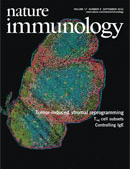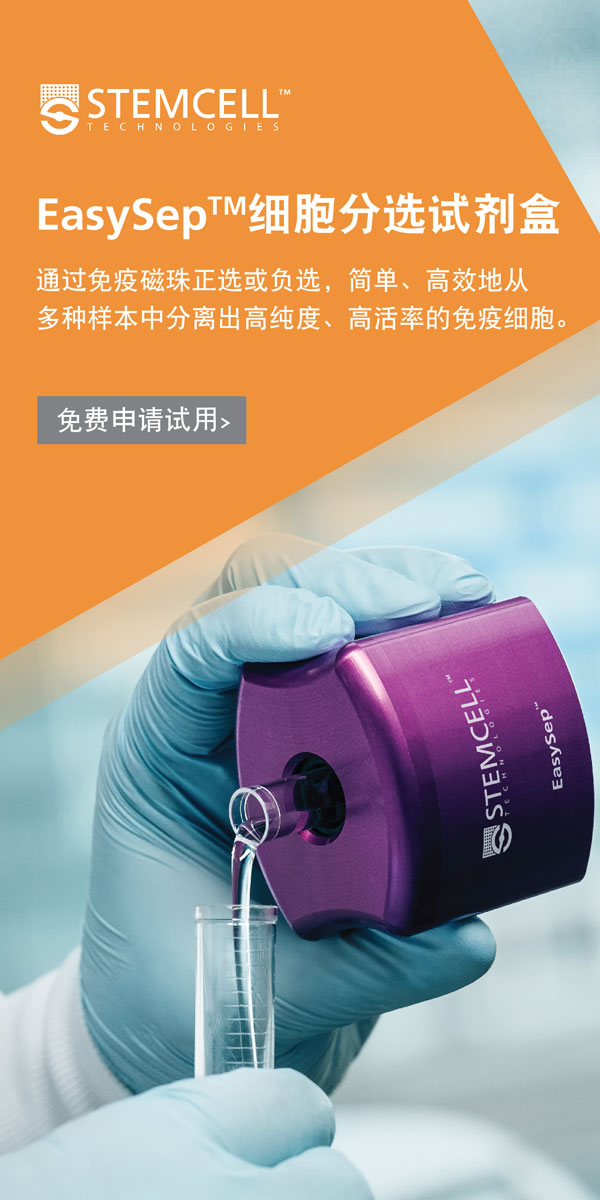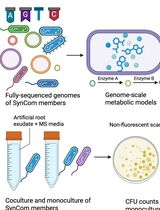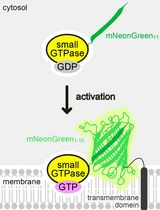- EN - English
- CN - 中文
In vitro Antigen-presentation Assay for Self- and Microbial-derived Antigens
自身抗原和微生物源性抗原的体外抗原呈递测定
发布: 2017年06月05日第7卷第11期 DOI: 10.21769/BioProtoc.2307 浏览次数: 18516
评审: Andrea PuharGuangzhi ZhangAnonymous reviewer(s)

相关实验方案
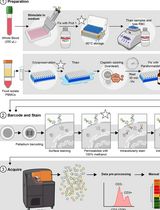
用于比较人冷冻保存 PBMC 与全血中 JAK/STAT 信号通路的双磷酸化 CyTOF 流程
Ilyssa E. Ramos [...] James M. Cherry
2025年11月20日 2252 阅读
Abstract
Antigen presenting cells (APC) are able to process and present to T cells antigens from different origins. This mechanism is highly regulated, in particular by Patter Recognition Receptor (PRR) signals. Here, I detail a protocol designed to assess in vitro the capacity of APC to present antigens derived from bacteria, apoptotic and infected apoptotic cells.
Keywords: Antigen presentation (抗原呈递)Background
T cell lymphocytes express on their surface the T cell receptor (TCR), which allows the recognition of cellular (self) or microbial (non-self) antigens that are processed and presented as peptides bound to the major histocompatibility complex (MHC) molecules by antigen presenting cells (APC). APC are able to process antigens and to present them to T cells, and MHC-TCR interactions are critical steps for T cell activation during both infectious and autoimmune responses.
Previous works have described a mechanism of regulation of antigen presentation based on the stimulation of Pattern Recognition Receptors (PRRs), such as toll-like receptors (TLRs) (Blander and Medzhitov, 2004 and 2006). Indeed, TLR signals specifically from phagosomes containing microbial pathogens favor the presentation of non-self-antigens within MHC-II molecules. On the other hand, self-antigens generated after phagocytosis of apoptotic cells are directed to lysosomal degradation because of the absence of TLR stimuli. However, the segregation of self and non-self-antigens does not occur when both derive from infected apoptotic cells and are simultaneously carried by the same phagosome, which is optimally tailored by TLR signals for antigen presentation. Such mechanism of phagosome maturation and antigen presentation upon TLR triggering has been demonstrated in vitro using bone marrow derived dendritic cells (BMDC) and apoptotic murine B cells–either primary or A20 B cell line–previously incubated with the TLR4 ligand lipopolysaccharide (LPS), which is internalized by B cells and mimics bacterial infection (Blander and Medzhitov, 2004 and 2006; Campisi et al., 2016). Despite its elegance, this experimental system fails to reproduce bacterial invasion of the eukaryotic target cell. Furthermore, no T cell traceable antigens are present in the apoptotic cargo that internalized LPS.
I developed an in vitro alternative protocol where A20 cells are directly infected by the cell invasive bacteria Listeria monocytogenes expressing a recombinant antigen, allowing to assess the capacity of BMDC to present self and non-self-antigens derived from the same infected apoptotic cargo (Campisi et al., 2016).
Materials and Reagents
- Sterile pipette tips and serological pipettes (Fisher Scientific, FisherbrandTM)
- Optilux non-tissue culture10 cm Petri dishes (Corning, catalog number: 430591 )
- Sterile 50 and 15 ml conical tubes (Denville)
- 1 ml syringe with 26 G gauge needle (BD, catalog number: 309625 )
- 70 μm cell strainers (Fisher Scientific, FisherbrandTM, catalog number: 22-363-548 )
- Tissue culture 24 well plates (flat bottom) (Corning, Costar®, catalog number: 3524 )
- Tissue culture 96 well plates (flat bottom) (Corning, catalog number: 3595 )
- Sterile bacterial inoculating needles or loops
- Sterile 5 ml tubes with cap for bacterial culture (Corning, catalog number: 352058 )
- Tissue culture 6 well plates (flat bottom) (Corning, Costar®, catalog number: 3516 )
- 20 G gauge needle (BD, catalog number: 305175 )
- 3 ml syringe (BD, catalog number: 309656 )
- FACS tubes with rack (National Scientific, catalog number: TN0946-01R )
- Mice:
- Wild-type C57BL/6J mice
Note: We initially purchased them from THE JACKSON LABORATORIES and then bred in the mouse facility of the Icahn School of Medicine at Mount Sinai for at least 5 years. - OT-II TCR transgenic mice (strain B6.Cg-Tg(TcraTcrb)425Cbn/J) (THE JACKSON LABORATORIES, catalog number: 004194 ), which express the mouse alpha-chain and beta-chain T cell receptor that pairs with the CD4 coreceptor and is specific for an epitope derived from the chicken ovalbumin (OVA323-339) in the context of I-A b
- 1H3.1 TCR transgenic mice, which express the mouse alpha-chain and beta-chain T cell receptor that pairs with the CD4 coreceptor and is specific for the 52-68 fragment of the alpha-chain of I-E class II molecules (the Eα52-68 peptide) in the context of I-A b
- Antigen sources:
- Cell cargo: A20 cell line (ATCC, catalog number: TIB-208 )
- Bacteria: Listeria monocytogenes expressing ovalbumin (OVA) as a recombinant protein (Pope et al., 2001)
- Purified peptides: OVA329-337 (sequence ISQAVHAAHAEINEAGR) and Eα52-68 (sequence ASFEAQGALANIAVDKA)
- 70% ethanol
- 1x PBS (Sigma-Aldrich, catalog number: D8537 )
- Red blood cell lysis solution (Sigma-Aldrich, catalog number: R7757 )
- Bacterial growing medium: brain heart infusion (BHI) broth (BD, BactoTM, catalog number: 237500 )
- Ampicillin (Sigma-Aldrich, catalog number: A9393 )
- Anti-CD95 antibody, clone Jo2 (BD, BD Biosciences, catalog number: 554255 )
- Trypan blue stain (Thermo Fisher Scientific, GibcoTM, catalog number: 15250061 )
- Fetal bovine serum (FBS)
- EDTA disodium dihydrate (Biological Industries, BI, catalog number: 41-922 ), to dissolve in PBS at pH = 8, stock solution 0.5 M
- Penicillin-streptomycin (Thermo Fisher Scientific, GibcoTM, catalog number: 15140122 )
- Anti-CD4 magnetic microbeads for T cell positive selection (Miltenyi Biotec, catalog number: 130-049-201 )
- Carboxyfluorescein succinimidyl ester (CFSE) (Thermo Fisher Scientific, eBioscienceTM, catalog number: 65-0850-84 )
- Anti-mouse CD4-APC, clone RM4-5 (Thermo Fisher Scientific, eBioscienceTM, catalog number: 14-0042 )
- Optional: anti-mouse CD11c (clone N418), CD11b (clone M1/70) and MHC-II (clone M5/114.15.2) markers
- RPMI (Sigma-Aldrich, catalog number: R8758 )
- GM-CSF
Note: We used to prepare GM-CSF using J558 cells transfected with GM-CSF cDNA (Liu et al., 2006, p.148), but recombinant GM-CSF can be also purchased. - L-glutamine (Sigma-Aldrich, catalog number: G7513 )
- HEPES solution BioXtra, 1 M, pH 7.0-7.6 (Sigma-Aldrich, catalog number: H0887 )
- Sodium pyruvate (Sigma-Aldrich, catalog number: S8636 )
- MEM, nonessential amino acids (Sigma-Aldrich, catalog number: M7145 )
- β-mercaptoethanol (Sigma-Aldrich, catalog number: M6250 )
- IMDM (Sigma-Aldrich, catalog number: I3390 )
- Fc-block: rat anti-mouse CD16/32, clone 2.4G2 (BD, BD Biosciences, catalog number: 553141 )
- Sodium azide (NaN3) (Sigma-Aldrich, catalog number: 13412 )
Note: This product has been discontinued. - BMDC medium (see Recipes)
- A20 cell medium (see Recipes)
- T cell medium (see Recipes)
- FACS buffer (see Recipes)
Equipment
- Single channel pipettes, 1, 20, 200 and 1,000 μl
- Scissors
- Forceps
- Laminar flow hood
- Bench top centrifuge
- Hemocytometer or automatic cell counter
- Cell incubator (37 °C, 5% CO2)
- Bacterial incubator (37 °C) with shaker
- Sterile 100 ml Erlenmeyer flasks
- Flasks for cell culture
- Optical density (OD) reader
- MACS columns, LS columns (Miltenyi Biotec, catalog number: 130-042-401 )
- MACS separators
Note: I suggest QuadroMACS separator (Miltenyi Biotec, catalog number: 130-090-976 ) - Flow cytometer
Software
- Flow cytometer analysis software, FlowJo, LLC
Procedure
文章信息
版权信息
© 2017 The Authors; exclusive licensee Bio-protocol LLC.
如何引用
Campisi, L. (2017). In vitro Antigen-presentation Assay for Self- and Microbial-derived Antigens. Bio-protocol 7(11): e2307. DOI: 10.21769/BioProtoc.2307.
分类
免疫学 > 免疫细胞功能 > 抗原特异反应
微生物学 > 微生物-宿主相互作用 > 细菌
细胞生物学 > 细胞信号传导 > 胞内信号传导
您对这篇实验方法有问题吗?
在此处发布您的问题,我们将邀请本文作者来回答。同时,我们会将您的问题发布到Bio-protocol Exchange,以便寻求社区成员的帮助。
Share
Bluesky
X
Copy link


